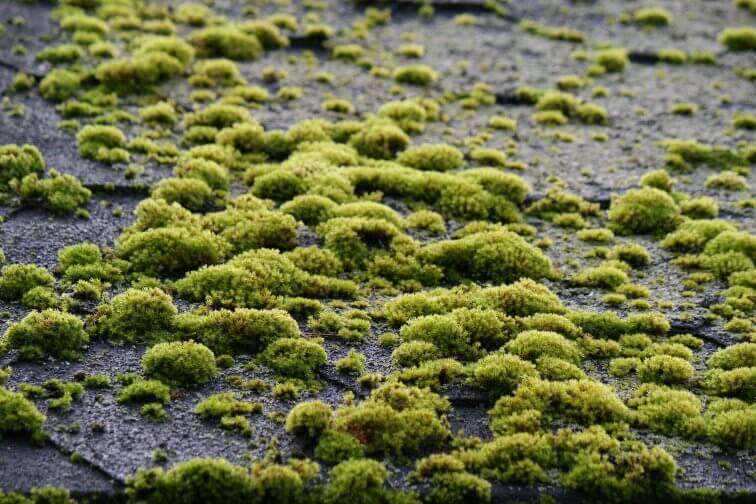
Your roof overgrown with thick moss can make your home look like it’s straight from a fairytale. Aside from that, moss on your roof can only degrade the shingles and do damage to the entire roof. Moss acts like a sponge, constantly absorbing moisture from its surrounding. You can save your roof from moss if it’s in small patches, but if it forms a thick layer it can cause leaking and shingle degradation. When left untreated for an extended amount of time, you will most likely need to redo your whole roof.
Proper roof ventilation can help to prevent the growth of moss on your roof by removing excess moisture from the attic. When the air in the attic is dry, it is less conducive to the growth of moss.
Luckily it isn’t very hard to deal with moss on the roof if a thick layer hasn’t formed yet. There are a lot of dry and liquid products that can help you clean your roof from moss and deal with it permanently.
Why Is Moss Growing on my Roof?
Simply said, because they like your roof, usually the north side of it! Cool and damp conditions are ideal for moss to thrive. If it grows on your roof, it’s probably because your roof is shaded either by trees in your yard or other structures nearby. Environments like these allow moisture to linger and moss to grow. Moss is a non-vascular plant meaning it doesn’t absorb water through its roots, but instead through its leaves. Moss reproduces with tiny seeds that are called spores, which are scattered around and eventually make their way onto your roof by wind, birds, squirrels, and other small animals. By virtue of their small size, spores can get in between roof shingles easily. Absorbing surrounding moisture like a sponge, it can spread across the whole roof and grow to be a couple of inches thick.

Why is Moss Bad for Shingles?
Moss attracts moisture like a sponge. The moisture from the moss can very easily make its way on and under the roof shingles, causing the lower levels of roofing felt and structural elements to be damp as well. This can easily lead to rot and then further decay of the roof. Untreated moss can destroy a roof in a matter of months.
Not all roofing materials last the same, for example, if the shingles are made from wood, the damaging process of moss will be even quicker, as wood is very porous, meaning that moss has more real estate to grow. If it is the asphalt roof moss can lift the edges of shingles, making them vulnerable to blowing off in a windstorm.
Should you remove moss from roof tiles?
The answer is yes! It’s still worth cleaning a roof properly even if you don’t see moss on certain parts of the roof; moss can still start to grow in areas that aren’t visible.
During the winter months, moss buildup can also contribute to dampness in a house and increase utility bills.
How to Remove Moss on Roof?
List of Materials and Tools to Have When Removing Moss from Roof
There aren’t many tools or materials needed to successfully remove moss from the roof. Be sure to use caution when climbing and standing on your roof and have a helper to not only secure your ladder but to pass your tools as well. Here’s everything needed to remove moss from the roof:
- Ladder
- Roof harness
- Safety glasses
- Garden hose
- Spray nozzle
- Pump spray bottle
- Moss cleaner
- Putty knife
- A garbage bag
After you collect the appropriate tools and materials for the job and have them handy you are ready to get started.
- Put on your protective eyewear and gloves.
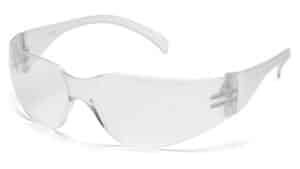
- Make sure the harness is put on correctly, and climb the ladder
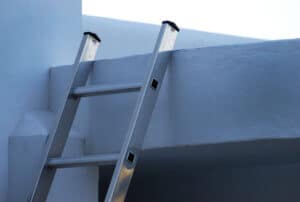
- Hose off the Roof with Water
The first step is to hose off the whole roof, to make sure the moss that is loose is dealt with sooner rather than later. Always make sure to spray from the top of the roof down so the water doesn’t damage, move or get in between the shingles and cause a leak. Also, make sure not to use too much water pressure as this can also damage the shingles.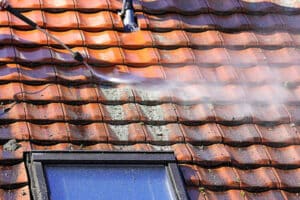
- Apply Moss Remover
After hosing the roof down, if there is still leftover moss, use a moss cleaner to get rid of it. Moss cleaners can be either a dry powder or a liquid. If you opt for a dry moss cleaner, it is best to put it on when rain is predicted for the near future. Put the cleaner in continuous horizontal lines about 2 to 4 feet apart, parallel to the roof ridge.
If you instead go for a liquid moss cleaner (like this), attach a garden hose to the container. Let the water run and wait for the moss cleaner to start flowing. Then apply the cleaner, starting from the roof ridge and working downward. Depending on the size of your roof, you could need only one bottle of moss cleaner, or several if the roof is larger.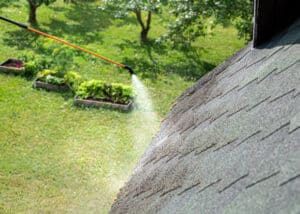
If there is any moss left ingrained in the shingles, you should consult a professional to see if they can repair it or if a new roof is needed.
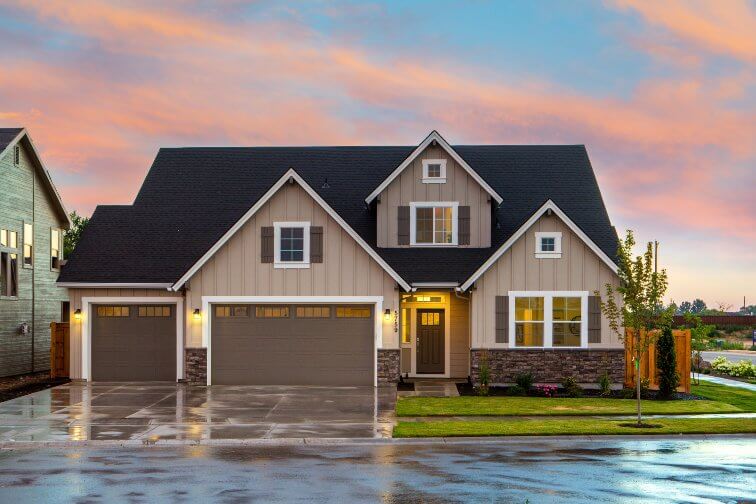
What to Avoid When Removing Moss from a Roof?
There is a lot of bad advice when it comes to cleaning moss from roofs. The main concern about these methods is not that they don’t clean the shingles properly, but they damage them as well. Using the incorrect method of cleaning could also void the limited warranty of the roof. It is always best to consult with a professional if you aren’t sure how to go about cleaning or repairing your roof.
Using Harsh Materials
If you can, try to avoid high concentrations of bleach and detergent. These chemicals not only damage the shingles, but also the surrounding materials. If significant damage occurs, the roof will most likely leak, and cause damage to the inside of the house as well. If there are any plants or flowers near the base of the house, they could easily get sprayed with these harsh chemicals and get ruined. Harsh chemicals are best to be avoided because they can cause more harm than good.
Scrubbing
Scrubbing the roof with a hard-bristle brush may seem like a good idea because of how strongly the moss grips the shingles. However, scrubbing strongly can easily damage asphalt shingles by removing their granules.
Pressure Washing
Don’t use a pressure washer to clean the roof because it can also ruin it. Pressure washers are certainly strong enough to break and lift up shingles. On asphalt types of roofs, pressure washers can strip their granule surface, destroying their color and ruining their performance.
How To Prevent Moss on Your New Roof?
A long-term solution can be ensuring no parts of the roof are in shade. Trim any branches you suspect are making shade and ensure the roof gets as much direct sunlight as possible. Make sure to keep the roof and the gutters free from leaves and debris, as they can be moisture collectors.
Metal strips on the ridge of the roof are the best long-term solution for moss on the roof. A copper, zinc or galvanized metal strip can make the roof unsuitable for moss, algae, and lichen to grow. Metal will oxidize over time. Because the strips are placed on the ridge of the roof, every time it rains the strips will be washed down the whole roof, making it much less habitable for moss, algae, and lichen. That’s why you sometimes see a gap in the moss next to an aluminium-sided dormer. Beware that adding a copper strip will take time for the inhibition of moss to start. Metal strips can’t deal with a present infestation of moss, they can only prevent them from happening.
If you need help with cleaning your roof from moss or are planning on redoing your roof, contact us for a free estimate or just a consultation!